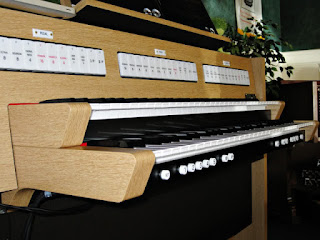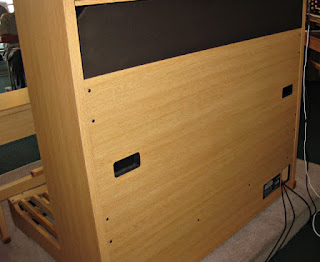
I had the opportunity early this month to attend a luncheon and demonstration of the new Roland C-330 Classic Organ by Hector Olivera at Heritage Church Organ Company.

I was initially intrigued by the size. With an older organ plus two external speakers taking up a large amount of space in my living room, the compact footprint of this new organ with satellite speakers that tuck away into the back of the organ would be a welcome change.

At first glance, the stops did not look impressive to me. With 33 stops, it seemed to cover just the very basics of organ registration.



Then the demonstration began, and I was amazed.
This tiny organ is magnificent. Beginning with Bach's organ in Arnstadt, Maestro Olivera took us on a wonderful journey through time, exposing us to organs throughout the world and through the centuries. Every one of these organs was played on this tiny new Roland, and I felt as if I were being transported to each church and cathedral as he played.
Then we were introduced to the orchestral oboe, clarinet, flute, and trumpet. I never imagined such sound could come from an organ! The pedal harpsichord was just icing on the cake.
The stoplist is extremely large, with three alternate voice palettes totaling 108 voices, plus an additional 72 which can be accessed on any keyboard through two user selected stops on each. Unlike with some other organs, palettes can be mixed and matched at will.
The keyboards have "true" tracker action (they even make wind noise when no stops are pulled), and are velocity sensitive for stops such as the orchestral trumpet.
My favorite feature, however is that no computer is needed to change the stops of the organ. Volume, octave, chiff, presence, warmth, windchest panning, and more are at your fingertips.

I can't even begin to cover everything that this organ does in one post. For more information, you can fill out a form on this website, or read the information on the official Roland site.
Oh, and if you want to buy one for me, I won't complain. :)
August 7, 2010 Update: I had the opportunity to play on this organ this past week at the BYU Organ Workshop. The built in speakers aren't nearly as powerful as the speakers in the above videos. They sound cheap. It also lacks a sub-woofer (which you can purchase separately), so the bass isn't as prominent, either. Also, in the bit of time I had to play with it, I did not see how to change all of the fun things (like chiff, presence, etc.). I was unable to mimic Hector's sounds. It is still a good little organ, and the price is "affordable," relatively speaking. It just wasn't as impressive when I played it as it was when Hector Olivera played it, which is to be expected, but was disappointing, nonetheless.














